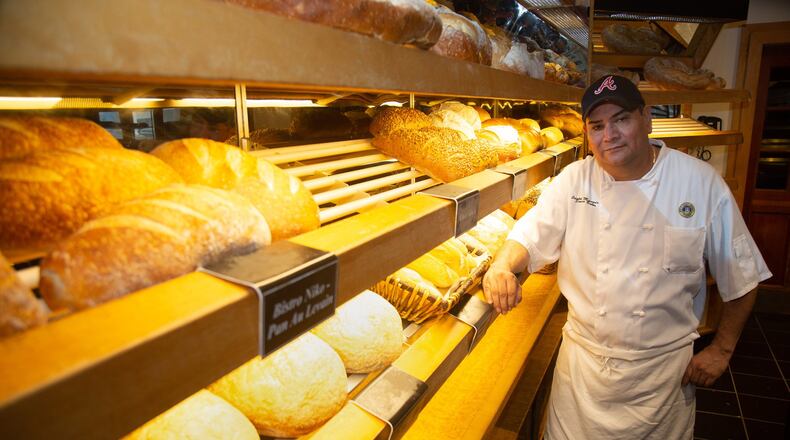Yes, we get it. You learned to bake bread. After months in quarantine with little to do thousands of people learned how to bake bread. We know this because Instagram and Facebook pages are flooded with pictures of banana breads, pizza doughs and your basic white breads.
But, it’s time to move on. It’s time to get back into the kitchen and graduate to bread baker extraordinaire. Yes, we mean you! It’s not as hard as it looks as long as you have the inside information on how to make it great and what to avoid. We chose two breads that are a bit more challenging, but that makes it all the more satisfying. It won’t be long before family and friends will be begging for more — not to mention being the envy of everyone on Instagram.
Gluten-free Bunny Bread
Bonnie Owings was a nurse who loved to bake and had health issues, including muscle ligament pain. It turns out that was a perfect combination to convert Owings into a gluten-free cook and baker. She also helped her son, Taylor, and daughter, Sally, open Sally’s Gluten Free Bakery. “My health issues went away when I became gluten-free but I couldn’t find any good gluten-free baked goods so the family eventually opened up the bakery in 2009,” she says. They now have three stores throughout metro Atlanta.
Tricks of the Trade: Owings likes the ingredients for the Bunny Bread to be at room temperature. Although the Bunny Bread does not require yeast, Owings said that when making a gluten-free yeast bread, the trick is to ensure that the liquid for the yeast starter should be warm, ideally around 110-degrees. Owings recommends using a thermometer. If the liquid is too hot, it will kill the yeast; if it's too cold the bread won't rise.
To get extra flavor, use fruit or vegetable purees such as applesauce or bananas to add moisture as well as help in binding. If you are making a gluten-free yeast bread, Owings says there is no need to roll the dough out nor knead it. Pour the mixture directly into the pan and place it in a warm area to let it rise. Since the Bunny Bread is yeast-free, Owings said it should go directly into the oven without needing the rising stage.
Challenge: The biggest challenge is not getting the bread too dry or heavy. Gluten-free breads require several flours, including rice or potato, as well as ingredients such as corn starch and tapioca to lighten it up and give it a better crumb. Rice flour usually is the base but it is heavier than the others so too much will make the bread heavy. Rice flour also absorbs more liquid so you need to counterbalance that absorption with liquids and proteins such as eggs. You also need ingredients such as xanthan gum, flax and psyllium to help with the binding.
“You have to tweak a lot with gluten-free recipes, add a little moisture, water or egg. It’s not like your mother’s bread.”
For first-time gluten-free bakers, Ownings suggests buying all-purpose gluten-free flour blends. She likes Bob’s Red Mill Gluten Free 1 to 1 flour.
Pain au Levain
Cristobal Miranda is the head baker at the Buckhead Bread Company, where he is in charge of providing the bread for all of the Buckhead Life Group restaurants. A native of Mexico, he has been with the Buckhead Life Group for 15 years.
Challenges: To get a perfect bread, Miranda believes in leaving it alone. After making the starter, he puts it back into the refrigerator and lets it rise for at least 16 hours. "I don't proof it right away. The more time it cools, the more flavor. Keeping it in the refrigerator is my one secret." Once the dough is made, let it rest for another 20 minutes before putting it in the pan and another 10 to 15 minutes after putting it in the bread pan. Since you let the starter proof the finished dough does not need as much time.
Tricks of the Trade: To make the crust look perfect, brush water on the top lightly prior to baking. Do not brush it with egg. He also is a fan of steam to make the bread crunchy and shiny on the outside and moist and fluffy inside. Be sure to make an "X" shape on the top of the bread. This is called scoring the bread and will allow for your bread to cook evenly.
The ice used in the recipe is to keep the temperature of the dough cool. By cooling it down, it allows for the correct texture to develop without making the flavor too similar to that of sourdough bread.
After baking the bread, let it rest a little while to finish fully cooking. The residual heat will make it even better if you do not cut into it right away.
Sally's Gluten Free Bakery. Three locations: Sandy Springs, Alpharetta and Druid Hills. sallysglutenfreebakery.com.
Corner Cafe & Buckhead Bread Company. 3070 Piedmont Road NE, Atlanta. 404-240-1978, buckheadrestaurants.com/restaurant/corner-cafe.
RECIPES
Bunny Bread
1 cup loosely packed almond flour
3/4 cup brown rice flour
12 tablespoons (3/4 cup) golden flax meal, divided
1/2 cup tapioca starch
1/2 cup amaranth flour
4 tablespoons corn-free baking powder
5 teaspoons psyllium husk powder
1 teaspoon finely ground sea salt
1 teaspoon baking soda
2/3 cup very warm water
1/4 cup avocado oil (or any mild-flavored oil, such as canola or light olive oil)
1/4 cup nut milk, water or milk of choice
3 tablespoons maple syrup
2 eggs, beaten
1 1/2 teaspoons apple cider vinegar
2 tablespoons cooked mashed sweet potato
Heat the oven to 325 degrees.
In a large bowl, combine the almond flour, brown rice flour, 6 tablespoons flax meal, tapioca starch, amaranth flour, husk powder, sea salt and baking soda. Set aside.
In a small bowl, blend the remaining 6 tablespoons golden flax meal and very warm water together to make a “flax egg gel.” Set aside for 5 minutes to gel.
Combine the oil, milk, maple syrup, beaten eggs, vinegar and sweet potato in a large mixing bowl or stand mixer bowl. Add flax egg gel. Stir gently until well blended.
Add dry ingredients to wet ingredients and mix on low speed until blended. Do not over-mix ingredients or you will lose leavening created by the soda and vinegar. The batter will be thick. Gently transfer batter to a lightly greased 8-by-4-inch loaf pan. Bake 40-50 minutes until a toothpick comes out cleanly.
Serves 8-10.
Per serving, based on 8: 297 calories (percent of calories from fat, 40), 6 grams protein, 39 grams carbohydrates, 7 grams fiber, 14 grams total fat (2 grams saturated), 47 milligrams cholesterol, 1,025 milligrams sodium.
Note: Amaranth flour can be purchased at Whole Foods, and Life Grocery. Husk powder and avocado oil can be purchased in Costco, Trader Joe’s, Aldi and Whole Foods.
Pain au Levain
9 cups high-gluten flour (such as bread flour) or substitute with all-purpose flour
Generous ¾ cups whole wheat flour
2¾ cups Sponge Starter (see note) (recipe follows)
1¾ cups Poolish (recipe follows)
Scant 1 cup water
2 tablespoons salt
1½ cups ice
Make Sponge starter and Poolish. Keep the Sponge Starter and Poolish separate until ready to mix all the ingredients.
In a stand mixer, combine the 9 cups of high-gluten flour and the whole wheat flour with the Sponge Starter and the Poolish. Add the water and, once incorporated, add the salt. Add half the ice (enough to cool down the dough and keep it from going sour), mixing the ice in until it melts. Feel the dough. If it is cool to touch do not add the remaining ice; if it is not cool to touch continue to add ice, mixing in the ice until it melts. After mixing everything, transfer the dough to a large bowl lightly greased with oil to keep the dough from sticking to the bowl. Cover with bowl with plastic wrap to keep it moist and let rest for about 20 minutes.
Heat the oven to 400 degrees.
The recipe provides enough dough to make three 1-pound loaves of bread. Divide the dough into three portions, shape each portion into a round and set it into a greased 6-inch circular cake pan. Alternatively, shape each portion into a standard loaf and set it into a greased loaf pan. The dough can also be shaped into longer torpedoes (like a baguette) or small rolls. Bake torpedoes on a greased baking tray. To prepare small rolls, grease muffin tins, break off bits of dough and roll each into a ball that fits easily inside the tin, leaving enough room for the dough to rise without overflowing during baking.
Before baking, score the dough by using a blade or sharp knife to cut a shallow X or a line across the top to allow for even baking. If baking rolls, make a tiny score.
Bake 12-15 minutes. Bake smaller loaves or individual-sized portions for 10 minutes; if more time is needed, check the bread every 2 minutes.
Makes 3 1-pound loaves. Total servings 24.
Per serving: 267 calories (percent of calories from fat, 5), 10 grams protein, 53 grams carbohydrates, 3 grams fiber, 1 gram fat (trace saturated fat), no cholesterol, 871 milligrams sodium.
Note: You will most likely have some remaining Sponge Starter and Poolish. You can combine the two and keep this in the refrigerator for up to 5 days. You can also use it in any other bread recipe that calls for a starter. You can also continue to “feed” it weekly and have your own sourdough bread starter. To feed it, stir in a scant 1 cup flour and ½ cup water. If you do not want to keep feeding it, you can incorporate a little bit into pancake and waffle batter, flatbread dough or pizza dough.
Sponge Starter:
½ cup dry yeast
2¼ cups room temperature water
3¼ cups bread flour or all-purpose flour
1½ tablespoons salt
Gently whisk the yeast and water in a medium-sized bowl. Add flour and salt and mix by hand.
Refrigerate, covered, for 12-16 hours. The sponge starter will double in size and may “bubble.”
Poolish:
½ cups dry yeast
2 ¼ cups water
3¼ cups bread flour or all-purpose flour
Gently whisk the yeast and water in a medium-sized bowl. Add flour and mix by hand.
Refrigerate, covered, for 12-16 hours. The Poolish will double in size and may “bubble.”
RELATED:
About the Author
Keep Reading
The Latest
Featured







